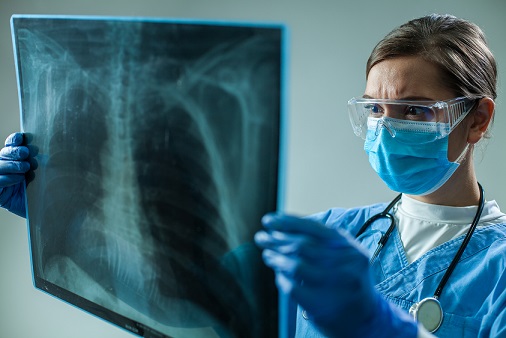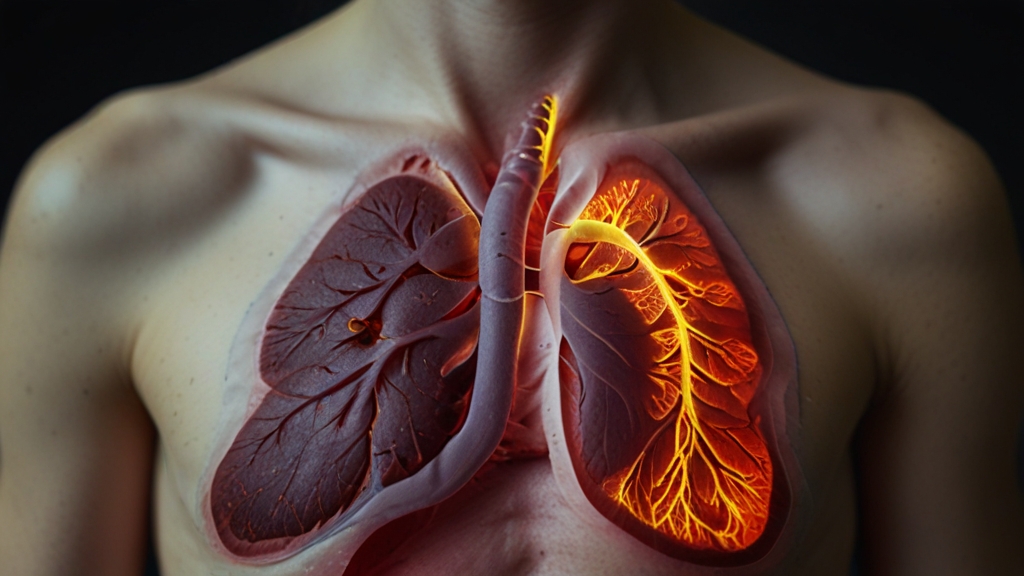Pleurisy, also known as pleuritis, is a medical condition that affects the thin lining of the lungs and chest cavity, known as the pleura. This condition can cause significant discomfort and pain, but with timely diagnosis and appropriate treatment, it can be managed effectively.
Overview:
Pleurisy occurs when the pleura becomes inflamed, leading to the two layers of the pleura rubbing against each other as the lungs expand during breathing. This friction can result in sharp chest pain, which is a hallmark symptom. The condition can be caused by various underlying factors, including infections, autoimmune diseases, and injury to the chest.
Risk Factors:
Several risk factors can increase the likelihood of developing pleurisy, including:
1. Infections:
- Viral infections, such as the flu or pneumonia
- Bacterial infections, such as tuberculosis or pneumonia

2. Autoimmune Diseases:
- Rheumatoid arthritis
- Lupus
- Sjögren’s syndrome
3. Lung Conditions:
- Pulmonary embolism
- Lung cancer
- Pleural mesothelioma
4. Chest Trauma:
- Rib fractures
- Blunt chest trauma
Symptoms of Pleurisy:
It is a condition characterized by inflammation of the pleura, the thin lining that surrounds the lungs and lines the chest cavity. The hallmark symptom of pleurisy is chest pain, but it can manifest with a range of other symptoms. Understanding these symptoms is crucial for identifying the condition and seeking appropriate medical care. Here are the common symptoms :
1. Sharp Chest Pain:
The most prominent and characteristic symptom is sharp, stabbing chest pain. This pain is typically:
-
Localized:
The pain is often felt on one side of the chest, where the inflamed pleura is rubbing against the chest wall.
-
Worsened by Breathing:
The pain intensifies when taking deep breaths, coughing, or sneezing, as these actions cause the pleura to move and rub against each other.
-
Described as Pleuritic:
Pleuritic pain is sharp and stabbing in nature and is different from the dull, aching pain associated with other chest conditions.

2. Shallow Breathing:
To avoid worsening the chest pain, individuals with pleurisy may naturally adopt shallow breathing patterns. They take small, shallow breaths, which can lead to respiratory discomfort and increased breathing rate.
3. Dry Cough:
The cough is typically unproductive, meaning it does not produce mucus or phlegm. It may occur as a result of the irritation caused by the inflamed pleura.
4. Shortness of Breath:
As it progresses, some individuals may experience shortness of breath, especially when the condition is associated with significant inflammation. The pleura’s inflammation can hinder the normal expansion and movement of the lungs, leading to breathing difficulties.
5. Fever:
In cases where pleurisy is triggered by an underlying infection, such as pneumonia, individuals may develop a fever. The fever is the body’s response to the infection and inflammation.
It’s important to note that it can vary in severity. While some individuals may experience mild discomfort and a low-grade fever, others may encounter more intense pain and severe breathing difficulties. The severity of symptoms often depends on the underlying cause and the extent of pleural inflammation.
Management of Pleurisy:
Pleurisy, an inflammation of the pleura, the thin lining surrounding the lungs and lining the chest cavity, can be a painful and discomforting condition. The management typically involves treating the underlying cause and alleviating symptoms. The specific treatment plan may vary depending on the cause and severity of pleurisy. Here’s an overview of how it is managed:
1. Treating the Underlying Cause:
The first step in managing pleurisy is to address the underlying condition responsible for the inflammation of the pleura. Common underlying causes include infections, autoimmune diseases, and lung conditions. Depending on the cause, treatment options may include:
- Antibiotics: If pleurisy is due to a bacterial infection, antibiotics are prescribed to treat the infection and reduce pleural inflammation.
- Antiviral Medications: In cases of viral pleurisy, antiviral drugs may be used to combat the viral infection.
- Anti-Inflammatory Medications: Nonsteroidal anti-inflammatory drugs (NSAIDs) or corticosteroids may be prescribed to reduce inflammation in autoimmune-related pleurisy.
2. Pain Management:
Managing the pain is an important aspect of treatment. Pain relievers and other techniques can help alleviate discomfort:
- Pain Relievers: Over-the-counter or prescription pain medications, such as acetaminophen or ibuprofen, can help relieve chest pain.
- Local Heat Application: Applying a warm compress to the affected area can provide relief by relaxing the chest muscles.
- Shallow Breathing: Encouraging shallow breathing to minimize chest movement can help reduce pain.

3. Rest and Recovery:
Adequate rest and recovery are crucial for the healing process. Rest allows the body to recover from inflammation and discomfort. During the recovery period, individuals are advised to:
- Limit Physical Activity: Avoid strenuous activities that may exacerbate the pain.
- Ensure Sufficient Sleep: Getting adequate sleep is essential for the body’s healing and recovery process.
4. Monitoring and Follow-up:
Regular monitoring and follow-up with a healthcare provider are essential to track the progress and ensure that the underlying condition is effectively managed. Follow-up appointments also help assess the need for any adjustments in the treatment plan.
5. Lifestyle Modifications:
In some cases, making certain lifestyle modifications can aid in the management :
- Smoking Cessation: If the patient smokes, quitting smoking is strongly recommended to improve overall lung health.
- Avoiding Environmental Toxins: Reducing exposure to environmental toxins, such as asbestos, can prevent pleural inflammation in the long term.
6. Surgical Interventions (in select cases):
In rare cases where pleurisy is associated with complications such as pleural effusion (accumulation of fluid in the pleural space), surgical interventions may be necessary to drain the fluid or perform other procedures to alleviate the underlying issue.

Prevention:
Pleurisy is often a result of underlying conditions, making prevention challenging. However, there are some general tips to reduce the risk:
- Maintain good respiratory hygiene, including getting vaccinated against respiratory infections.
- Practice safety measures to prevent chest injuries and trauma.
- Manage underlying conditions effectively through regular medical check-ups and adherence to treatment plans.
Prognosis:
The prognosis varies depending on the underlying cause and the timeliness of diagnosis and treatment. In most cases, pleurisy can be managed effectively with appropriate medical care. However, the prognosis may be less favorable if it is associated with severe underlying conditions such as cancer or pulmonary embolism. Timely intervention and follow-up care are essential for a better prognosis.
In conclusion, pleurisy is a condition characterized by inflammation of the pleura, resulting in chest pain and discomfort. Understanding the underlying cause is crucial for effective management and treatment. With the right medical intervention, it can be managed, and in many cases, patients can expect a full recovery. If you experience symptoms of pleurisy, seek prompt medical attention to determine the cause and receive appropriate care.
Frequently Asked Questions (FAQ) About Pleurisy:
Pleurisy is a condition that can be concerning and may lead to various questions. Here are some common questions and answers about pleurisy to help you better understand this condition:
What is pleurisy?
Pleurisy, also known as pleuritis, is an inflammatory condition that affects the pleura, a thin membrane that surrounds the lungs and lines the chest cavity. This inflammation causes the two layers of the pleura to rub against each other, resulting in sharp chest pain.
How does a person get pleurisy?
It can be caused by various factors, including infections (viral or bacterial), autoimmune diseases like rheumatoid arthritis or lupus, lung conditions such as pulmonary embolism, and chest trauma or injury.
Which is a key characteristic of pleurisy?
The typical symptoms include sharp chest pain, worsened by breathing, coughing, or sneezing, shallow breathing, dry cough, shortness of breath, and in some cases, fever.
How is pleurisy diagnosed?
A healthcare provider typically considers the patient's medical history, performs a physical examination, and may order imaging tests like chest X-rays or CT scans. Blood tests, including inflammatory markers, may also be used to assist in the diagnosis.
How serious is a pleurisy?
Pleurisy itself is not typically life-threatening. It is usually a symptom of an underlying condition, and the prognosis depends on the severity and management of that underlying cause. Prompt diagnosis and treatment can help manage it effectively.
Can pleurisy be prevented?
Preventing pleurisy may not always be possible, as it often results from underlying conditions. However, maintaining good respiratory hygiene, managing underlying diseases, and taking safety measures to prevent chest injuries can help reduce the its risk .
What is the first line treatment for pleurisy?
Treatment involves addressing the underlying cause, such as infections or autoimmune diseases. Pain management through pain relievers and local heat application can help alleviate discomfort. In some cases, lifestyle modifications and rest are also recommended.
Is pleurisy transmissible?
Pleurisy itself is not contagious. However, if the underlying cause is an infectious agent, such as a virus or bacteria, that underlying infection can be contagious.
Can pleurisy go away and come back?
It can recur if the underlying condition that caused it persists or reoccurs. For example, if someone has recurring respiratory infections, they may experience recurrent episodes of pleurisy.
When should I see a doctor ?
You should seek medical attention if the pain is severe, persistent, or associated with difficulty breathing. Prompt evaluation is essential to identify the cause and begin appropriate treatment.
What is pleurisy?
Pleurisy, also known as pleuritis, is an inflammatory condition that affects the pleura, a thin membrane that surrounds the lungs and lines the chest cavity. This inflammation causes the two layers of the pleura to rub against each other, resulting in sharp chest pain.
How does a person get pleurisy?
It can be caused by various factors, including infections (viral or bacterial), autoimmune diseases like rheumatoid arthritis or lupus, lung conditions such as pulmonary embolism, and chest trauma or injury.
Which is a key characteristic of pleurisy?
The typical symptoms include sharp chest pain, worsened by breathing, coughing, or sneezing, shallow breathing, dry cough, shortness of breath, and in some cases, fever.
How is pleurisy diagnosed?
A healthcare provider typically considers the patient's medical history, performs a physical examination, and may order imaging tests like chest X-rays or CT scans. Blood tests, including inflammatory markers, may also be used to assist in the diagnosis.
How serious is a pleurisy?
Pleurisy itself is not typically life-threatening. It is usually a symptom of an underlying condition, and the prognosis depends on the severity and management of that underlying cause. Prompt diagnosis and treatment can help manage it effectively.
Can pleurisy be prevented?
Preventing pleurisy may not always be possible, as it often results from underlying conditions. However, maintaining good respiratory hygiene, managing underlying diseases, and taking safety measures to prevent chest injuries can help reduce the its risk .
What is the first line treatment for pleurisy?
Treatment involves addressing the underlying cause, such as infections or autoimmune diseases. Pain management through pain relievers and local heat application can help alleviate discomfort. In some cases, lifestyle modifications and rest are also recommended.
Is pleurisy transmissible?
Pleurisy itself is not contagious. However, if the underlying cause is an infectious agent, such as a virus or bacteria, that underlying infection can be contagious.
Can pleurisy go away and come back?
It can recur if the underlying condition that caused it persists or reoccurs. For example, if someone has recurring respiratory infections, they may experience recurrent episodes of pleurisy.
When should I see a doctor ?
You should seek medical attention if the pain is severe, persistent, or associated with difficulty breathing. Prompt evaluation is essential to identify the cause and begin appropriate treatment.



